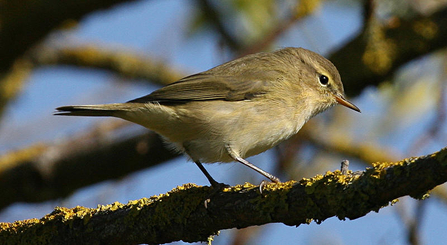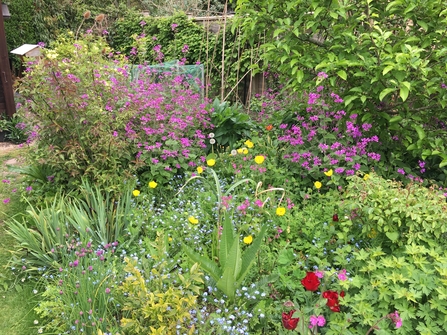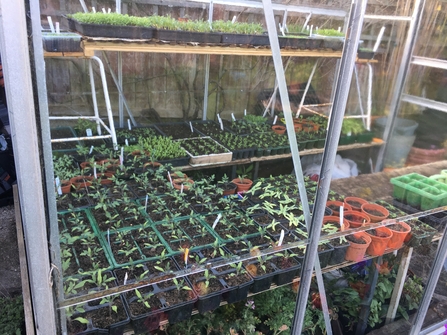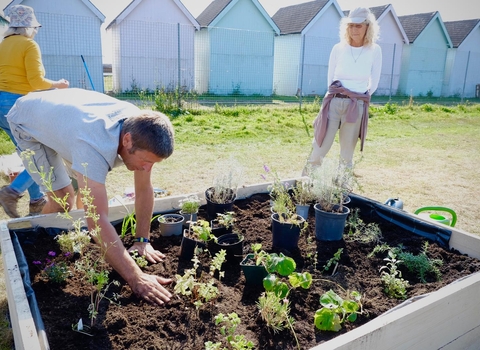Spring has to be my favourite season - it's probably everybody’s! Everything is fresh, full of hope and promise. At no other time of year can you see change happen each day: whether it be buds opening into blossom on the fruit trees, the sudden appearance of a brimstone butterfly searching for nectar or the calling notes of the first chiff chaff of the season.
My Wildlife Garden: Spring
© Andy Sutton

Chiffchaff © Ken Dolbear
The chiff chaff is usually the first migrant that we hear, followed by the blackcap, though we heard a willow warbler this time singing in willows behind the garden which is unusual. It was probably passing through on its way north.Blackbirds and house sparrows have been busy collecting nesting material. A combination of roses, honeysuckle and clematis provides a dense canopy in which they can nest, along with the occasional pair of collared doves.
It has definitely been a 'daffodil year' everywhere and we are now getting a great display of tulips. Neither of these are attractive to bees, but other insects take an interest, and I will be collecting seed from the native daffodils in the front lawn to grow on.

© Andy Sutton
In the meadow the crocuses have given way to cowslips, and the rest of the lawn will be getting the 'no mow May' treatment! The results of surveys from around the world recently published show a massive decline in insects. As they support the lower end of most food chains, it's crucial that we provide the conditions they need to thrive to enable populations to increase. Our Top Bar beehive is ready and waiting to receive a swarm as and when one becomes available. If bees arrive soon, they should be able to take advantage of the May (hawthorn) blossom which is abundant in our area, as is bramble which will be a great standby for midsummer.
When I get a moment, I sit in a sunny spot with a cup of tea and just watch and listen - which I highly recommend. You become aware of the birdsong, the myriad of insects going about their daily routines and the sheer beauty of the flowers of all shapes and sizes. We have seen several species of butterfly now - orange tip, possibly attracted by the garlic mustard, which is everywhere, commas and holly blues. Also, a pair of speckled woods, dancing in mid-air.
This spring has been exceptionally dry, so there has been much watering to plants in containers, with water butts nearly empty! The veg plot is coming along apace. Companion planting is a great way to control pests organically and is a further way the add biodiversity to the garden. Flowers such as calendula (pot marigold), tagetes, phacelia and nasturtiums are great for attracting ladybird and hoverfly larvae which control aphids, for example, and sown among the vegetables they add colour and link up with the original 'cottage garden' style of times past when vegetables, fruit and flowers were wisely all grown together.

© Andy Sutton
I always grow our plants from seed, and I realise I am fortunate in having the space to do this, but in these financially challenging times plants are becoming expensive to buy ready grown, so if space and time allow this could be well worth trying, and it can be rewarding as well as producing plants with a smaller carbon footprint!
I am keeping my eyes peeled for any overhead bird activity, particularly for returning swallows and martins – our beloved swifts are always the last to arrive back, but very welcome.
We reach the end of seasonal reports from our wildlife garden, having covered all four seasons.
It has been a privilege to share the joy we get from gardening with nature, rather than against it. A few changes here and there in the way we garden and in what we grow can make a considerable difference for our beleaguered wildlife. So, do give it a go and create a much-needed sanctuary for all wild things, animals and plants.
Andy and Gill Sutton
Andy and Gill live in Totton. Andy is now retired from a career in agriculture and horticulture. Before the pandemic, Andy was helping a local primary school with their wildlife projects and looks forward to returning to the project soon.

© Trish Gant
Feeling inspired?
Help us create a Wilder Future.
We’ve reached a point where our natural world is in critical condition and needs our help to put it into recovery. It’s not too late to bring our wildlife back, but we must act now.
Join #TeamWilder to create a #WilderFuture and take action for nature’s recovery today.




